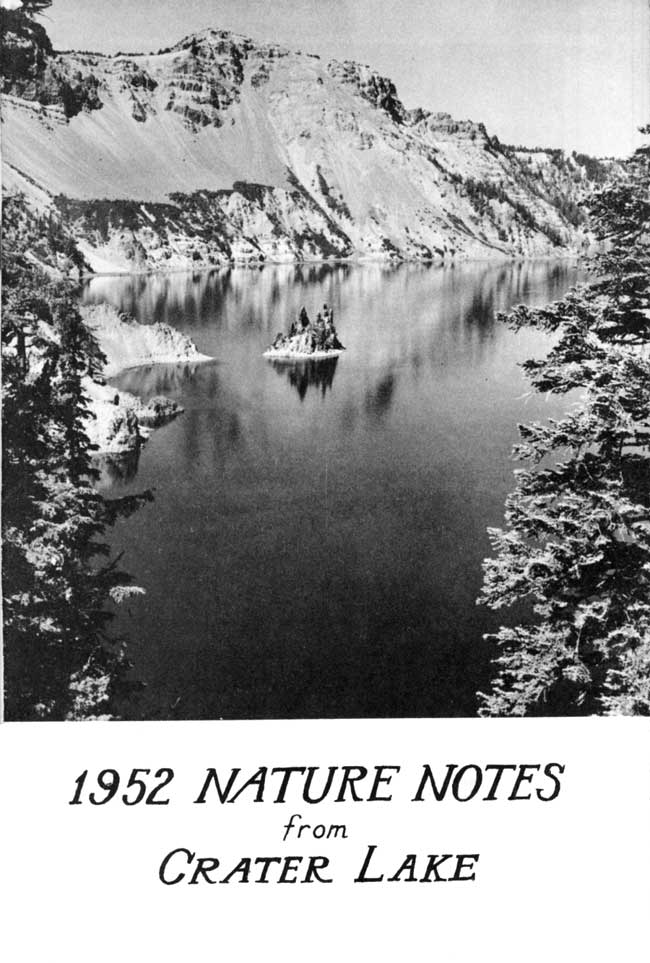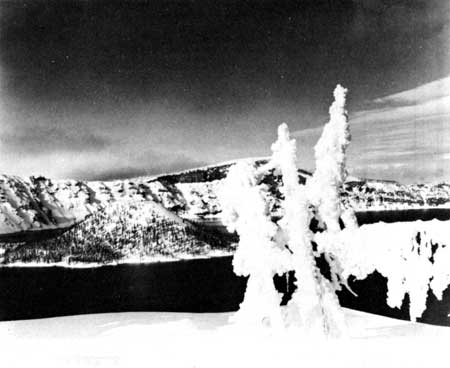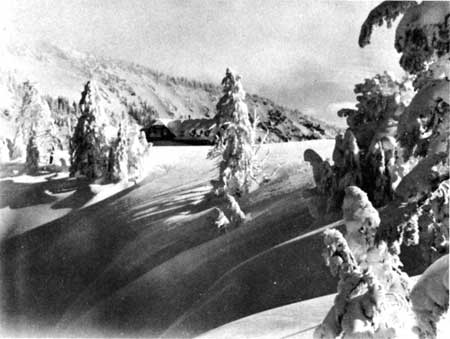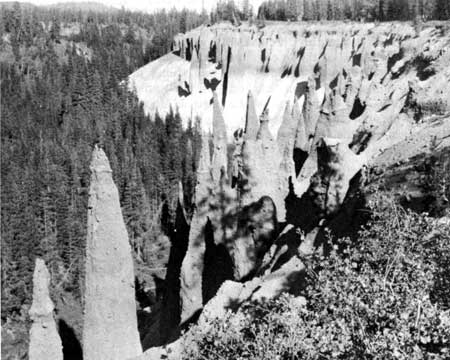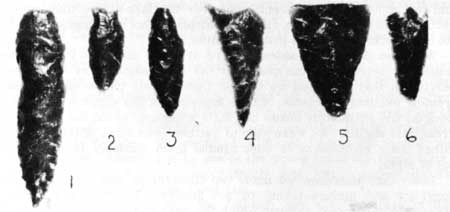Volume 18, page 1, 1952
All material courtesy of the National Park Service. These publications can also be found at http://npshistory.com/
Nature Notes is produced by the National Park Service. © 1952
The Big Snow of 1951-52
The winter of 1951-52 at Crater Lake was preceded by a long dry summer during which there was practically no precipitation after May 13 until the first general fall storms. Most of the residents of the park were anticipating an “easy” winter but by April of 1952 all of us knew we had been through a winter of record breaking snowfall and snow depths.
Weather records have been kept in the park for about 26 years except for the war years and these records show that the average snowfall for Crater Lake is 622.0 inches. This average has been exceeded each year since 1948 and for several winters previously. The record snowfall for the park occurred during the winter of 1932-33 when 879.0 inches of snowfall was recorded between October 1, 1932 and September 30, 1933, which is the weather year for the park.
Snow depths on the ground are in direct proportion to the snowfall so that recorded depths of between 100 inches and 200 inches of snow are common. These greatest depths of snow usually occur during the months of January, February, and March. For example, snow depths for March 1949, 1950, and 1951 were recorded at the Park Headquarters weather station as 171, 180, and 197 inches respectively.
The past winter, however, while not breaking any records for snowfall did result in the greatest recorded depths of snow on the ground since park records have been kept. On March 1, 1952 there was 177 inches of snow on the ground which was only 31 inches from the record. A storm which began on the 3rd and ended on the 8th resulted in 39 inches of snowfall and increased the total depth to 200 inches. It was at this point we realized that if the normal cycle of storms continued, we would break a record. Thereafter, each storm, even though adding to our inconvenience of living and working in heavy snow, was watched with interest and anticipation. Another storm moved in from the southwest on the 9th and continued through the 15th and gave us another 38 inches of snowfall. The depth as recorded reached 201 inches, only 7 inches shy of the record we still hoped would be broken. There still remained 15 days of the month of heaviest snowfall – we should see the record broken.
March 16 was clear and comparatively warm, maximum temperature 37 degrees. Still another storm crossed the Cascades on the 17th and continued through the 20th. This storm carried enough moisture to satisfy our anticipation. In four days 42 inches of snow fell. At the beginning of this four day period the measured depth on the ground was 198 inches. On the second day a total depth of 207 inches was recorded – only one inch shy of the record. Then on the 18th 6 inches of snow fell followed by 10 inches more on the 19th. This was it! At 4:00 P.M. on the 19th the measuring stake recorded 216 inches. The record had been smashed but it continued snowing, and we speculated on how much greater the depth would be. On the morning of March 20, 1952 the measurement reached 224 inches of snow on the ground. During the day, however, the storm moved on and the new snow gradually settled to 218 inches, still a record.
By the end of March there had been measured 798 inches of snowfall, and we now set our sights on the breaking of the record for total snowfall, but this was not to be. The last snowfall on June 14, brought the total to 835 inches, some 44 inches short of a record.
The snowpack for the winter, which is measured periodically to determine water content, was found to be more compact and with more water than for many years previously. Water users in the entire state of Oregon were assured an ample supply for the coming season.
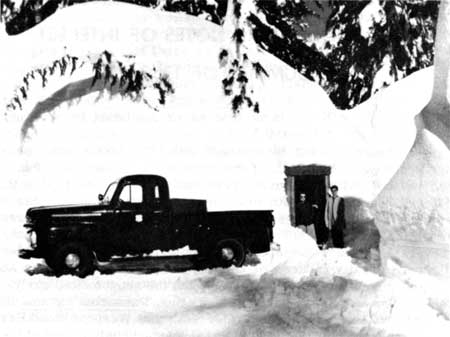
The big snow of 1951-52 as shown by Chief Ranger Hallock’s photographs.
Ornithological Notes of Interest Summer of 1952
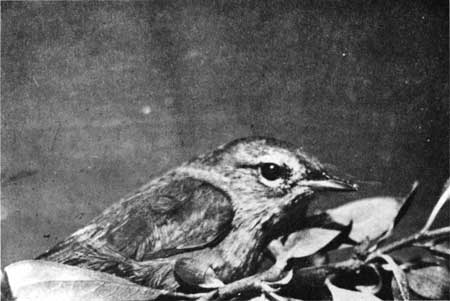
Macgillivray warbler photographed in the headquarters area. From a Kodachrome by Ranger-Naturalist Ralph Welles and Florence Welles.
The summer of 1952, by contrast with 1951, was unusual because of the prolonged persistence of the snow and a consequently much delayed season. Although causal relations must be assumed with the greatest of caution and with much more investigation than has been possible, it is nevertheless interesting to note certain differences between the two seasons.
Several species whose upward altitudinal limits fluctuate substantially were greatly reduced or entirely absent from elevations above 6000 feet in contrast to last summer when the snow melted early. Included in this group are the Lazuli Bunting, Passerina amoena (Say); Fox Sparrow, Passerella iliaca (Merrem); and Western Wood Pewee,Contopus richardsonii (Swainson). Also conspicuously absent at higher elevations were Turkey Vultures, Cathartes aura (Linnaeus).
Perhaps the most spectacular change in the avifauna from last summer was the conspicuous decline in numbers of Red Crossbills, Loxia curvirostra Linnaeus. During the summer of 1952 I saw about 0.9 crossbills per hour in the field compared to 5.5 per hour in 1951. During 1952 they were only in restless flocks whereas in 1951 singing males were observed commonly. Also in 1951 groups feeding in cones or “mineral pecking” could be observed from small distances. Pine Siskins, Spinus pinus (Wilson), however, continue to be common this summer. Huge flocks of several hundred individuals were observed frequently in the Headquarters Area during late July and early August.
It is of interest, to note further, that there was a conspicuous reduction in the numbers of Rosy Finches, Leucosticte tephrocotis (Swainson). This has been particularly noticeable on Dutton Ridge where they were very abundant during the summer of 1951.
There was also a reduction in the density of breeding Lincoln Sparrows, Melospiza lincolnii (Audubon), in the higher montane meadows. The study area in the upper Munson Meadow which I have had under observation for several summers had only two, possibly three, breeding pairs compared to the usual five or six. Although I do not have quantitative data, a similar reduction appears to have occurred in other high-elevation meadows. It seems quite likely that the persistence of the snow in these areas may have been responsible. It should be noted also that there has been a noticeable reduction in the numbers of Dippers, Cinclus mexicanus Swainson, appearing in the upper portions of the streams in mid-summer. Whether this represents a reduction in population or a restrictive effect of the snow on the normal mid-summer migration to higher elevations is not clear.
Despite the fact that there was a severe reduction in the cone crop on the whitebark pine, ponderosa pine, and firs, compared with 1951, there was, during the summer of 1952, a marked increase in Clark’s Nutcrackers, Nucifraga columbiana (Wilson). This is noticeable throughout the high country as well as at the Rim Village, although more pronounced at the latter. It is of interest to note that we saw a considerable number of color-banded individuals which were banded during the summer of 1950 but which failed to reappear during the summer of 1951. The movements of this species continue to be enigmatic! There was also a remarkable increase in the number of Ravens, Corvus corax Linnaeus, observed. At least three small flocks, probably family groups, were observed repeatedly. These were commonly seen in the vicinity of Park Headquarters, Rim Village, and the Watchman, respectively.
Also of interest were the substantially greater recorded numbers of Booming Nighthawks, Chordeiles minor (Forster). Mr. and Mrs. Jack D. Lee reported observing them nightly at Lost Creek in Pinnacle Valley. I confirmed this on three occasions. They were apparently similarly common in the Panhandle. I also observed nighthawks at Arant Point on July 8 and above Castle Creek Canyon (5800 ft.) on August 5.
Several important observations were obtained on swallows. On July 28, I saw three Cliff Swallows, Petrochelidon pyrrhonota (Vieillot), within the Crater wall near Garfield Peak. This is the second record for the Park. On August 2, Ranger-naturalist C. F. Yocom and I saw two Rough-winged Swallows along the Garfield Peak Trail. These are the first records for the Park since 1937 and the first for the Lake area. On July 19 I found a nest of Violet Green Swallows, Tachycineta thalassina (Swainson), in a cavity in one of the Wheeler Creek Pinnacles. This is the first breeding record for the Park.
Despite the heavy snow, the population reproductive activity, and upward migration of Blue Grouse, Dendragapus obscurus (Say), was quite normal.
References
Farner, Donald S. 1951. Ornithological notes of interest. Crater Lake Nature Notes,17:16-18.
Farner, Donald S. 1951. The Red Crossbill irruption of 1951. Crater Lake Nature Notes,17:19.
Farner, Donald S. 1952. The Birds of Crater Lake National Park. University of Kansas Press, ix-200 pp.
A New Record in the Park for the Oregon Red Salamander
One of the rarest animals in Crater Lake National Park is the Oregon red salamander. Lawrence Bisbee, foreman of the fire guards, found the first specimen to be collected in the Park on August 7, 1951, under a pile of boards near the Annie Spring Campground. Intensive search in suitable habitats throughout the Park failed to reveal other specimens until July 5, 1952. On that evening six additional specimens of this salamander were found by a group of individuals under rocks and in rotten wood at the edge of Vidae Falls. The Oregon red salamanders that have been found in the Park are intergrades between two subspecies as is indicated by the scientific name, Ensatina eschscholtzil oregonensis x platensis. It is particularly interesting to note that the Vidae Falls collection establishes a new altitude record for this genus of salamanders – about 6700 feet in the Hudsonian life zone.
The Use of the Wheeler Creek Pinnacles by Nesting Birds
The Pinnacles of Sand Creek and Wheeler Creek have long been of interest to geologists because of their contribution to our knowledge of the pumice-scoria flows which descended the southern slope of Mount Mazama prior to its collapse. These Pinnacles are the results of the most intense fumarolic activity in the Park (Williams, 1942:8990). In this activity pumice and scoria were hardened in vertical columns by ascending gasses. The present form of the Pinnacles is the result of the modification of these original columns by wind and water erosion. Some of the Pinnacles are actually hollow and are sometimes referred to as “fossil gas vents.”
Curiously little attention has been given to the fact that the pinnacles are of some ornithologic interest. Frequently they are used by birds as song perches in the same manner as dead trees are used. Of even greater interest, however, is the use of small cavities in some of the Pinnacles as nesting cavities. There are at present records of the use of such cavities by three species of birds. On June 26, 1952, I saw a pair of Mountain Chickadees, Parus gambeli Ridgway, carrying material into one of these cavities. Although I was unable to be certain, it appeared that the material was items of food indicating that the eggs had already been hatched. On the same day Park Naturalist Harry C. Parker and I observed a pair of Mountain Bluebirds, Sialia currucoides Bechstein, entering repeatedly an opening in one of the Pinnacles. At the time, we could not feel certain that nesting activity was in progress. However, on July 29 I saw a female enter the same opening and on August 4, saw both male and female carrying insects into the cavity. In the vicinity were two juvenile bluebirds apparently completely independent of the adults. They were catching insects on the wing. It would appear quite possible that these juvenile birds were from the first brood with which the observations of June 26 could be associated, whereas the food-carrying observed on August 4, was doubtless in conjunction with the rearing of the second brood.
On July 19, 1952, I discovered a pair of Violet-green Swallows, Tachycineta thalassina(Swainson), carrying food into a cavity in the Wheeler Creek Pinnacles. The young could be seen and heard plainly. Although Violet-green Swallows have been observed (Farner, 1952:74) rather frequently in Wheeler Creek Canyon and elsewhere in the Park, this is actually the first breeding record.
It should be noted that both the bluebirds and chickadees normally nest in cavities in tree trunks. The Pinnacles thereby constitute a curious, although understandable, substitute for tree trunks.
It is further of interest to note that Rough-winged Swallows, Stelgidopteryx ruficollis(Vieillot), have also been known to breed in Wheeler Creek Canyon (Farner, 1952:75). However, it appears that holes in the cliffs, rather than holes in the Pinnacles, are used.
References
Farner, Donald S. 1952. The Birds of Crater Lake National Park. University of Kansas Press. ix + 190 pp.
Williams, Howell 1942. The Geology of Crater Lake National Park, Oregon. Carnegie Institution of Washington Publication 540. vi + 162 pp.
Nature Photography in Color in Crater Lake National Park
In nature photography it is axiomatic that you must take the picture when you see it, because it may not be there the next time you look. This implies the necessity of special equipment and a special willingness to go to work at any time, because wild life has a time clock of its own.
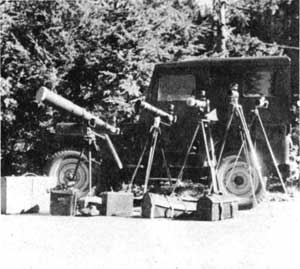
Photographic equipment used by Ranger-Naturalist Welles and Mrs. Welles during the summer of 1952.
I recall the particularly colorful yellow-bellied marmot that used to sit in the late afternoon on a rock in the meadow back of headquarters. We never saw him except in the late afternoon when the light was almost gone. I had watched for him there several times during the day but he never put in an appearance, so I finally realized that I would have to get him on his own terms and took his picture that evening about six o’clock. The next morning a marmot was found dead on the highway in the same vicinity, and while it may be merely coincidence, a particularly colorful marmot never appeared on that rock in the meadow again.
It is our belief that wild life should be photographed in the field as much as possible under natural conditions and natural light and natural habitat. In order to do this, Mrs. Welles and I carry with us most of the time a jeep-load of cameras, lenses, tripods, and miscellaneous equipment. This includes four Leicas, a Kodak Bantam, and lenses ranging in focal length from 35 mm to 640 mm. At all times we keep three Leicas mounted on telephoto lenses – a 300 mm, the 500 mm, and the 640 mm – with direct viewing repriscopes, each with its own special tripod. This leaves one Leica free for the interchangeable use of the 35 mm, the two 55 mm, the 85 mm and the 150 mm lenses for scenic, habitat shots and so forth. We employ flash guns, Strobe light and restrictive handling only when it appears impossible to get a picture any other way. For instance, a bat must be either held in the sunlight or taken with a flash because of his light shunning habits. Photographically speaking, the 1952 season at Crater Lake National Park was highlighted by the discovery and the subsequent coverage of a den of Cascade red foxes, a nest of bald eagles and the habitat of a great gray owl.
The red foxes were first reported to me on July 7th by Assistant Chief Ranger Packard, who went with me that afternoon to their den about half a mile beyond the Rim Village off the north road. After searching the area for about half an hour and finding no evidence of foxes, we decided we must be in the wrong location, and turned to go. As is so often the case, we found that although we had not seen it, we had been under observation by one of the young foxes for some time. He was sitting on the ridge about thirty feet away, apparently as curious about us as we were about him.
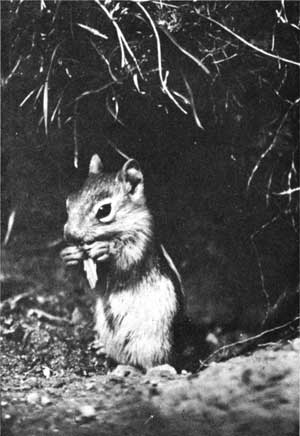
A very young golden mantled ground squirrel taking what is perhaps his first bite of rotten wood. From a kodochrome by Ranger-Naturalist Ralph Welles and Florence Welles.
I got one shot of him with the 500 mm, and with the click of the shutter he vanished back of the ridge. We saw no more of him that day, but during the following two weeks my wife and I had the opportunity of observing the entire fox family and photographing them around their various dens as they moved farther and farther away from human interference. The three young ones became for a time almost indifferent to our presence, because, as is well known, the parent foxes have a great deal of difficulty in teaching their young to be afraid. We eventually were able to photograph all three of the young almost at will, but were able to get only distant shots of the wary adults. In this connection it is of interest to note that whereas most male carnivores will eat their young if given the opportunity, the male red fox helps take care of the young until they are able to take care of themselves.
The last time we visited their den, on July the 23rd, we saw no sign of the young foxes, nor did we hear the peculiarly eerie wild barking of the parents in the deep hemlock forest below the ridge.
In the meantime, on July 18th, former Superintendent E. P. Leavitt told us about a bald eagle’s nest at Diamond Lake, and we went with him immediately to locate it. He had only visited the locality once and then by boat from Diamond Lake Lodge, and as the lake was too rough to take a boat out that day, we drove around to the near vicinity, but could not identify the nest.
Returning two days later, we inquired at the fish hatchery whether anyone knew where the eagle’s nest was, and were promptly offered a boat ride across the lake by Jay Hoover of the Fish and Game, who knew where it was, and who landed us on the marshy shore about a hundred yards from the one hundred fifty foot fir in the top of which could be plainly seen the clutter of sticks we were looking for. For a half an hour or so there was no sign of life in the dense forest in which we found ourselves except for the clouds of mosquitoes which seemed to be impervious to the insect repellent we had with us.
Looking almost directly up at the nest we could see no young in it and the adults were apparently out over the lake at the time, so we occupied ourselves with a close-up telephoto shot of the nest to show its construction, and also general habitat shots.
While so doing we suddenly heard at some distance through the trees the weird, loud cacaphony of the adult eagle’s cry of alarm. Moving in that direction we almost immediately came upon an extremely exciting spectacle. Close together in the high top of a dead Douglas fir, with white heads and tails gleaming in the sun were two great bald eagles. We were able to get two good shots of them before either their excitement or ours caused them suddenly to soar away out of sight.
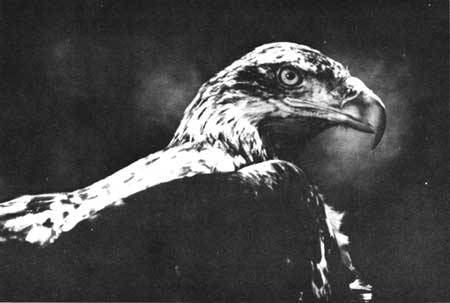
Two-year old bald eagle. From a kodachrome by Ranger-Naturalist Ralph Welles and Florence Welles.
Later that afternoon we made two discoveries that facilitated observation and picture-taking of our quarry. There was a narrow opening in the forest through which the nest could be seen from the road, and secondly, by climbing the mountain on the other side of the road about fifty yards we found that we could observe not only the nest but that there were two very young but not small nor “baldheaded” eagles in it. Although it was to be several weeks before “the babies” could fly, they were already nearly as large as their parents and their heads were still as dark as the rest of them as they would continue to be for three or four years.
From our view-point on the mountain we set up our 500 mm and 640 mm cameras and waited. It was two hours before we had the gratification of seeing and photographing a parent eagle swoop down with breath- taking swiftness and alight on the edge of the six-foot nest and proceed to tear up what appeared to be a large white bird and feed it to the young.
We saw them at weekly intervals up until the time of this writing. When last we observed them one of the adults was no longer putting in an appearance, the young were learning to fly, stretching and flapping their great wings (they already had a wing-spread of approximately six feet), sometimes rising two or three feet, then settling back down.
A more complete record of our experience with the great gray owl is contained elsewhere in this issue of Nature Notes.
It would be easy, not to say delightful, to spend an entire summer photographing the golden mantled ground squirrel, the Olympic black bear or the Clark nutcracker. A book could be written about how we came into possession of a great horned owl which we eventually banded (with the help of Ranger-Naturalist Wally Ernst, who was of invaluable aid to us on that and many other occasions) and turned loose on Dutton Ridge. I could write about the courage and tenacity for life of the badger that we found stunned and bleeding on the road where he had been struck by a passing vehicle.
You can see pictures of these and many others and hear their story when you attend the Naturalist talks at Crater Lake National Park.
Indian Relics on Mt. Mazama
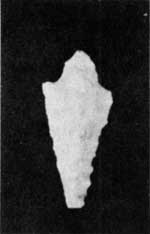 Fig. 2 |
On August 11, 1952 an arrowhead (Fig. 2) was brought to the Information Building by a visitor who had found it that morning at the viewpoint near Discovery Point, not far from the plaque which calls attention to glacial scratches on rock at the Rim. It is quite possible that this arrowhead was exposed by the heavy thundershowers which occurred during a four-day period shortly before the day on which it was found. This becomes the seventh Indian point in the park collection, earlier finds having been made in Godfrey Glen (Fig. 1, Nos. 1,2,3) along the first turn in the highway leaving the Rim Village (Fig. 1, No. 4) and on the upper part of the Garfield Peak Trail (Fig. 1, Nos. 5,6). The unique feature of this arrowhead is that it has been made from opaque whitish-colored rock, whereas all of the others are of are of translucent obsidian.
The Indians which once lived in this region are known to have been superstitious of Crater Lake and Mt. Mazama, considering the area to be the home and battleground of the gods. For this reason they established their camps a considerable distance away from the mountain and seldom ventured near this sacred abode. One of their legends, however, provides some clear evidence they occasionally hunted in the forests on the slopes of Mt. Mazama itself (Homuth, 1929). Our growing collection of Indian points contributes significantly to the belief that this and other Indian legends concerning Mt. Mazama may contain considerable basis in fact.
Reference
Homuth, Earl U. 1929. An Indian Legend. Nature Notes from Crater Lake, 2(3):2-3.
The Northern Mountain Lizard
The small lizard, Sceloporus graciosus gracilis Baird and Girard, often called “mountain swift”, because of its ability to move so rapidly, is not at all common in Crater Lake National Park. It is usually found in dry, fairly open areas where there are logs or old stumps in which it seeks cover when disturbed. Because these lizards are so elusive there are many more recorded observations than there are specimens in the Park collection.
Until this year, the northern mountain lizard had been recorded in only three localities within the Park. These were Wheeler Creek Canyon, the Rim above the Palisades, and the east side of Annie Creek in the Park panhandle. The only specimens from the Park had been taken at Wheeler Creek Canyon in 1948 by D. G. Findlay and D. S. Farner. Individuals had also been observed just outside the south boundary in the dry brushy country east of Annie Creek and it was there that Dr. D. S. Farner collected a specimen in 1948.
During the summer of 1952, several new observations were made and a specimen was collected which furthered our knowledge of the distribution of this lizard both within and adjacent to the Park. On July 29 Ranger-Naturalists Ralph Welles, Richard M. Brown, and the writer saw several individuals along the fire motorway east of Annie Creek near the south boundary but were unable to capture them. Ranger-Naturalists Brown and I returned to the area on August 4 and managed to secure two specimens. One was caught just outside the Park boundary, the other barely inside it. They were both obtained by Brown, using a snare on a fishpole.
The other record of this Sceloporus was obtained by Dr. Albert P. Blair and Arthur Barclay on August 6. They observed two northern mountain lizards at the Wineglass about 40 feet up from the lake. Both Richard Brown and the writer searched unsuccessfully for them several days later.
The Sedentary Habits of Canada Jays
It has long been suspected that individual Canada Jays, Perisareus canadensis(Linnaeus) are normally restricted throughout their lives to a relatively small area (Farner, 1952:76). Of course such a hypothesis can be definitely confirmed only by the observation of marked individuals. Results thus far obtained from the banding of Canada Jays in Crater Lake National Park strongly support the hypothesis although more data are needed to understand fully the degree of restriction of movement among these birds.
Canada Jays have been banded at Park Headquarters and at Annie Spring. Most of them have been marked with the numbered aluminum bands of the U.S. Fish and Wildlife Service and with colored aluminum bands supplied by the Massachusetts Audubon Society. Using two- and three-band combinations, always with at least one numbered aluminum band, it has been possible to give each bird a distinctive combination allowing identification without recapture.
Twenty-seven banded Canada Jays have been observed at least once after banding. Of these, ten were not seen after the season of banding. Of the remaining seventeen one was recorded nine years after banding; two, four years after banding; three, three years; two, two years; and nine, one year after banding. At least nine of the seventeen are known to be alive at the time of this writing.
In seeking banded Canada Jays we vigorously inspect three areas: the Rim Village and Rim Campground, Annie Spring Campground, and Park Headquarters. In the course of field work in other parts of the Park all Canada Jays encountered are carefully examined with field glasses for bands.
It is quite amazing to note that with only one exception all twenty-seven birds, involving more than a hundred observations, invariably have been observed within 200 yards of the banding site. The single exception (Farner, 1947:31) was a bird banded by W. T. Frost at Annie Spring on December 27, 1937, and recovered on August 6, 1947, about one mile from the banding locality.
It is of interest to contrast our experience with Canada Jays and our experience with Clark’s Nutcracker, Nucifraga columbiana (Wilson). Nutcrackers have been banded at Rim Village, Park Headquarters, and Annie Spring. It is by no means an uncommon experience to find Nutcrackers banded at one station appearing at the other two, either in the same or different seasons. In two cases we found evidence of almost daily movements between Annie Spring and the Rim Village. We also have observed banded Nutcrackers along the West side of the Rim several miles from the banding site at the Rim Village. This experience with Nutcrackers is cited primarily as evidence to indicate that were there similar movement by Canada Jays, we would have detected them. Although more data are needed in order to be conclusive, there is certainly every reason to believe that the Canada Jays of this area are extremely sedentary.
References
Farner, Dorothy C. 1951. Banding Crows and Jays. Crater Lake Nature Notes, 17:12-15.
Farner, Donald S. 1947. An interesting recovery of a banded Gray Jay. Bird-Banding, 18(1):31-32.
Farner, Donald S. 1952. The Birds of Crater Lake National Park. University of Kansas Press. ix + 200 pp.
Other pages in this section


